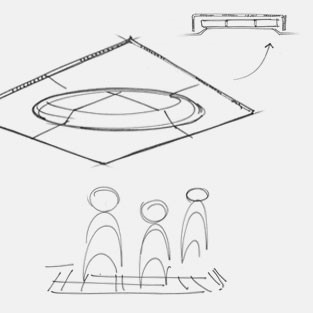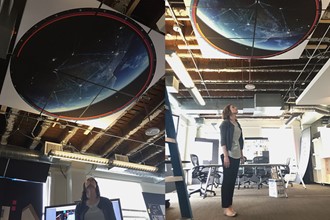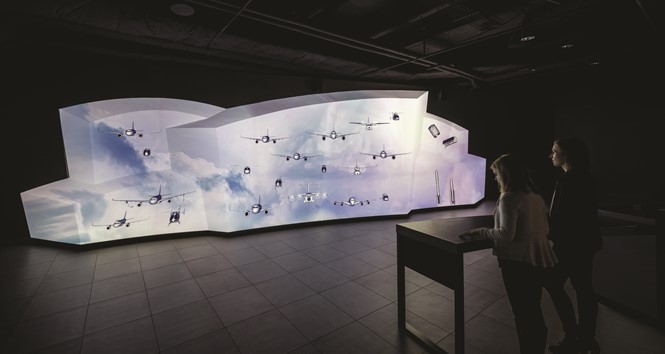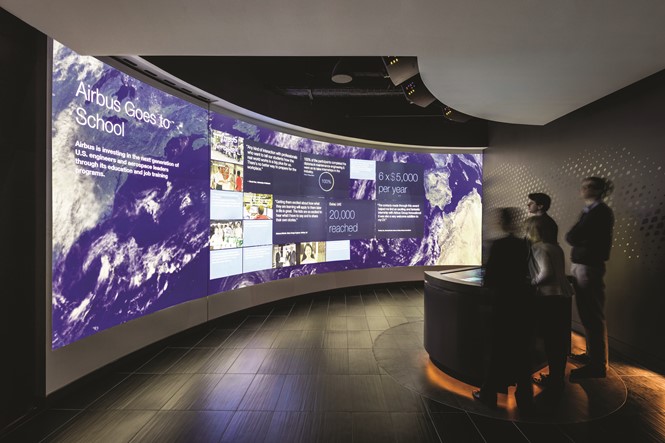Brand experience: Airbus Group
Airbus Group’s Experience Center is the highlight of its new Washington, D.C. office. The technology-driven space focuses on the key characteristic defining the brand – its connection to the sky. Brittany Golob examines the exhibition
Over the centuries, people have looked to the sky seeking inspiration or answers, discovery, travel or information. But that urge to look upwards still exists.
For a company like Airbus Group, whose business spans from defense and space to aircraft and helicopter manufacture, the sky is an unmistakable, unshakeable part of the brand. The company even uses a dark, night sky blue as its primary colour. When brand and design agency Hornall Anderson began working with Airbus on its new Experience Center, the sky became an important theme.
Despite the group’s different divisions, the centre would be representative of the entire organisation, prompting the need for a unifying storytelling thread. “What it came down to was the concept that the sky connects us all,” Kevi Louis- Johnson, design director at Hornall Anderson, says. The agency was commissioned to turn part of Airbus Group’s new 20,000 square foot Washington, D.C. office facility into a dedicated Experience Center through which invited visitors could engage with the brand.
“They wanted it to be a space that was alive,” Hornall Anderson’s director of experience design Mark Buchalter says, regarding the dual-purpose space. It is now the home base for Airbus’ employees in Washington and offers them the opportunity to host clients – the likes of which range from U.S. Congressmen to business partners to diplomats – in a unique environment.
Rick McGivern, Airbus Group vice president of the group experience team says, “It allows us to demonstrate many of our industry-leading innovations, and helps us detail the Airbus Group people and places in the U.S. and beyond, our industry partners, and how we are improving the way everyone travels, secures and defends, here in the U.S. and around the world.”
Flexibility was one of the main considerations when designing the experience. Rather than create an exhibit of standing aircraft models and static descriptions – a kind of mini-Smithsonian – Hornall Anderson ensured Airbus would have the ability to adapt the experience to the visitor. Thus, the experience is a mostly digital one.
The first exhibit is an oculus in the waiting room ceiling offering a 24-hour time-lapse animation of the earth, depicting Airbus Group’s activities throughout an average day. Beyond that is the second-biggest exhibit, a 30-foot curved wall before a touchscreen table that acts as a briefing room to being the experience. But, the briefing room is unique in that it is customisable.


Louis-Johnson says the briefing room’s interface uses technology to assist the host in sharing data and simplifying complex information. “It’s about the two people having a conversation, but the technology is a beautiful backdrop bringing it to life,” she says. However, with the variety of visitors coming through the centre, the content had to be easy to understand, easy to change and easy to digest in short spurts. The result is a collage of video, photos, headlines, bite- sized bits of content and data that get the key points across while allowing for more conversation without relying on long video clips or static essays posted onto walls.
By centring the experience on the Airbus Group brand, it can broaden the understanding and perception of the company. “We looked at the current perceptions for those audiences as well as how we might want to shift those perceptions. It boiled down to the three primary takeaways at the end of the day.
Essentially, it’s to describe who Airbus is, who makes up Airbus and what Airbus makes,” Buchalter says. The experience continues with an innovation gallery that highlights Airbus Group’s contributions to flight and defense technology. This is the most museum-like part of the centre as it uses a mix of fixed placards and photographs with an open workspace. Finally, a 40-foot wall projects interactive 3D models of aircraft onto a sculpted surface to bring Airbus Group’s work to life.
Though the technology used throughout the Experience Center makes it a unique place to visit, the real benefit is in its ability to tell stories about Airbus Group. Hornall Anderson developed content alongside Airbus to highlight activity from each of the group’s divisions. The digital and physical information presented at the centre is changeable to reflect the ever-evolving nature of Airbus Group’s endeavours.
One such story is of the Perlan Project, of which Airbus Group is the headline sponsor. The unique venture will send a glider up 90,000 feet into the stratosphere to understand how conditions close to that of Mars affect aircraft. Airbus Group can put this sponsorship at the forefront through the Experience Center to help it explain its contribution to science and innovation.
The actual implementation of the content into the Experience Center was streamlined by the fact that the resulting exhibit aligns closely with the initial brief set to Hornall Anderson. The agency worked with the architects designing the building, but also built to scale models to plan out how the technology and physical space would interact. Louis-Johnson says, “It was important that everything integrated seamlessly, that it didn’t feel like screens on a wall. We wanted it to feel very dynamic.” The 8,000 square foot centre is thus comprised of the screens and touchtables that make the experience viable, as well as the metals and durable materials that comprise the structure of the exhibits. Blue is the primary colour, not only because of its use in Airbus Group’s colour palette, but because of its connection with the sky.
Ultimately, the way the space is structured caused only a few minor variations from the prototyping phase, largely to enable the technology to function properly. The CMS working behind the scenes of the experience was also developed to be easy to use and update, so that content could be altered at will by Airbus Group employees.
For Airbus Group, the Experience Center has introduced the opportunity to build relationships with clients and other stakeholders by sharing with them the group’s core values, activities and scientific and industrial work. Buchalter says initial feedback from Airbus has lauded the centre’s usefulness in being able to start conversations the company wants to have.
Neither Airbus Group nor its new Experience Center would be anywhere without the sky. “This notion of the sky connecting us all puts Airbus in a place where it’s actually bigger than them. It’s around this notion of how we all in modern society connect across the globe,” Buchalter says. Whether it’s the Apollo astronauts or the great astronomers like Kepler and Galileo or the civilisations that navigated by the stars or the ancients who told stories about the night sky or the more familiar modern use of space for travel and communications, the human relationship with the sky is driven by curiosity, discovery, inspiration, science and adventure; to infinity and beyond.














